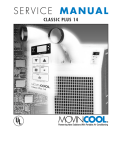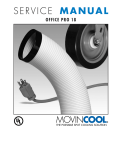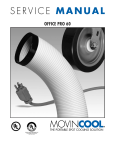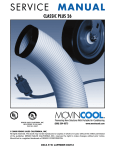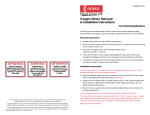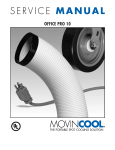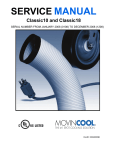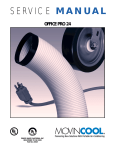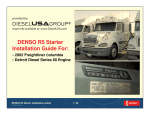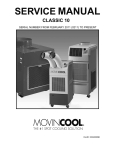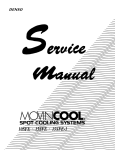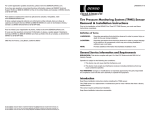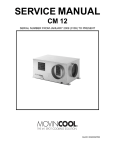Download MovinCool Office Pro 12 Service manual
Transcript
SERVICE MANUAL O FFICE P RO 1 2 © 1998 DENSO SALES CALIFORNIA, INC. All rights reserved. This book may not be reproduced or copied, in whole or in part, without the written permission of the publisher. DENSO SALES CALIFORNIA, INC. reserves the right to make changes without prior notice. FOREWORD This manual has been published to service the MovinCool Office Pro 12. Please use this service manual only when servicing the Office Pro 12. DEFINITION OF TERMS WARNING: Describes precautions that should be observed in order to prevent injury to the user during installation or unit operation. CAUTION: Describes precautions that should be observed in order to prevent damage to the unit or its components, which may occur during installation or unit operation if sufficient care is not taken. NOTE: Provides additional information that facilitates installation or unit operation. GENERAL PRECAUTIONS WARNINGS: • • • • • All electrical work if necessary, should only be performed by qualified electrical personnel. Repair to electrical components by non-certified technicians may result in personal injury and/or damage to the unit. All electrical components replaced must be genuine MovinCool, purchased from an authorized reseller. When handling refrigerant, always wear proper eye protection and do not allow the refrigerant to come in contact with your skin. Do not expose refrigerant to an open flame. The proper electrical outlet for MovinCool units must be equipped with a “UL” approved ground-fault breaker to prevent electrical shock from the unit. When brazing any tubing, always wear eye protection and work only in a well ventilated area. i ii GENERAL DESCRIPTION Generally speaking conventional air conditioners cool the entire enclosed environment. They act as “heat exchangers”, requiring an interior unit (evaporator) to blow cool air into the interior and an exterior unit (condenser) to exhaust exchanged heat to the outdoors. Unlike conventional air conditioners, the MovinCool Spot Cooling System is a spot cooler which directs cool air to particular areas or objects. MovinCool Spot Cooling Systems have the following features: CONDENSER (OUTDOOR UNIT) Conventional Air Conditioner 1. Compact Design The innovative design of MovinCool has resulted in one compact unit, replacing the need for two separate units. 2. Easy Transportation and Installation With the whole cooling system built into one compact unit, MovinCool requires no piping and can be easily transported and installed. 3. Energy Conservation MovinCool is economical because it cools only the area or objects which need to be cooled. Office Pro 12 1 EVAPORATOR (INDOOR UNIT) GENERAL DESCRIPTION 2 2.40 21.20 CONSTRUCTION AND SPECIFICATIONS 12.40 18.50 11.30 3.80 43.90 7.50 ø11.575 4.60 16.50 20.67 27.40 19.30 Exterior Dimensions (units: inches) 3 2.20 CONSTRUCTION AND SPECIFICATIONS 1. Basic Construction The MovinCool Spot Cooling System is compact in construction because the condenser and the evaporator are enclosed in one unit. The interior is divided into three sections. The upper front face is equipped with the evaporator, while the lower front face contains the drain tank. The rear section contains the condenser, the compressor and the control box. 2. Air Flow Air drawn from the right side face passes through the condenser which extracts the heat. This hot air is blown out through the upper exhaust air duct. Air taken in from the front face is cooled by the evaporator and then blown through the cool air vent. All the air inlets are equipped with filters, while the exhaust air duct is protected by wire mesh. EXHAUST AIR OUT COOL AIR OUT EVAPORATOR AIR IN 3. Compressor and Fans The compressor is hermetically sealed. A twospeed fan motor is used with two centrifugal fans to draw air across the evaporator and condenser. 4. Drain Tank The capacity of the drain tank is 5.0 gallons (19 liters). The unit is equipped with a full tank LED and a device to automatically stop the unit’s operation when the drain tank reaches a level of approximately 4.0 gallons (15 liters). 4 CONDENSER AIR IN CONSTRUCTION AND SPECIFICATIONS Rating Conditions dry bulb ................................................................. 80 oF (26.6 oC) wet bulb ................................................................ 67 oF (19.4 oC) humidity ................................................................. (50%) Specifications power frequency ................................................... 60Hz line voltage ............................................................ single phase 115 V power consumption .............................................. 1.23 Kw current consumption ............................................. 10.7 Amps power factor .......................................................... 95% starting current ...................................................... 32A power wiring .......................................................... 14 (3-core) AWG Cooling Unit cooling capability .................................................. 2,870 Kcal/hr .............................................................................. 11,480 BTU/hr cooling system ...................................................... direct expansion Blower type of fan ............................................................. centrifugal fan air volume: ............................................................. Evaporator (Hi speed) 441 ft 3/min .............................................................................. Condenser (Hi speed) 823 ft 3/min motor output ......................................................... 0.14 Kw (Hi) .............................................................................. 0.08 Kw (Lo) Compressor type ....................................................................... rotary output .................................................................... 0.8 Kw refrigerant type ...................................................... R-22 refrigerant capacity ............................................... 0.95 lbs (0.43 kg) Safety Devices compressor overload relay .................................... included fan motor protector ............................................... included anti-freezing thermister ......................................... included full drain tank switch.............................................. included power interruption feature ..................................... included time delay feature .................................................. included Dimensions & Weight W x D x H in. (mm)................................................. 21.2" x 27.4" x 44" (539 x 696 x 1118) weight lbs. (kg) ...................................................... 165 (75) Operating Conditions inlet air (relative humidity) ...................................... 95 oF (35 oC), < 50% .............................................................................. 65 oF (18.3 oC), > 50% Control Device temperature control .............................................. included programmable timer .............................................. included two speed fan........................................................ included Specifications Specifications are subject to change without notice. 5 CONSTRUCTION AND SPECIFICATIONS EXHAUST AIR VENT COOL AIR VENT EVAPORATOR CENTRIFUGAL FAN CONDENSER CAPILLARY TUBE DRAIN TANK COMPRESSOR DRAIN SWITCH CONTROL BOX Construction of Office Pro 12 6 CONSTRUCTION AND SPECIFICATIONS EVAPORATOR FAN CONTROL PANEL TOP PANEL EXHAUST AIR VENT RIGHT HANDLE COOL AIR VENT SIDE PANEL FAN MOTOR FRONT PANEL CONDENSER FAN CAPILLARY TUBE EVAPORATOR COMPRESSOR ACCUMULATOR DRAIN TANK CONDENSER CASTER POWER CORD Construction Diagram 7 CONSTRUCTION AND SPECIFICATIONS @ 115V @ 115V 3.6 (14.3) 14 (25.2) Temperature ˚C (˚F) Cooling Capability (x103 kcal/h (BTU/h)) 3.2 (12.7) 2.8 (11.1) 12 (21.6) 10 (18.0) 8 (14.4) 2.4 (9.5) 6 (10.8) 2.0 (7.9) 40 50 60 70 Relative Humidity of Inlet Air (%) Cool Air Temperature Difference Curve 30 (86) 25 (77) @ 115V 1.6 20 (68) 10 (50) 15 (59) 20 (68) 25 (77) 1.4 Power Consumption (kW) 15 (59) Wet Bulb Temperature ˚C (˚F) Cooling Capability Curve 1.2 1.0 0.8 35 (95) Dry Bulb Temperature ˚C (˚F) Dry Bulb Temperature ˚C (˚F) 35 (95) 30 (86) 25 (77) 20 (68) 15 (59) 15 (59) 20 (68) 25 (77) Wet Bulb Temperature ˚C (˚F) Power Consumption Curve 8 30 (86) REFRIGERANT SYSTEM 1. The component parts of the refrigerant system include the following: • Compressor • Evaporator • Condenser • Accumulator • Capillary tube These parts are all connected by copper piping. All the connections have been brazed. EVAPORATOR CONDENSER CAPILLARY TUBE ACCUMULATOR COMPRESSOR REFRIGERANT FLOW CONDENSER ACCUMULATOR CAPILLARY TUBE FAN MOTOR EVAPORATOR Refrigerant System 9 COMPRESSOR REFRIGERANT SYSTEM 2. Compressor The compressor used for the unit is hermetically sealed. The compressor and the compressor motor are in one casing. A. Compressor Construction The construction of a rotary type compressor is divided into two mechanisms. The drive mechanism (compressor motor) and the compression mechanism (compressor). When the rotor shaft of the motor (drive mechanism) turns, the roller of the compressor (compression mechanism) rotates to compress the refrigerant. B. Basic Compressor Operation The roller (compression mechanism) is set eccentrically with a certain distance given from the axis of the center of the cylinder. A spring loaded blade is mounted on the cylinder. The roller turns to compress the refrigerant in the space between the cylinder and eccentrically mounted roller. The blade is in contact with the roller by means of spring force. It partitions the space between the suction side and the discharge side to keep compressed refrigerant from returning to the suction side. Compressor Operation There is no suction valve. The discharge valve is designed not to open until the pressure of the refrigerant within the cylinder reaches or exceeds that of the refrigerant on the discharge side. It thus prevents the backward flow of discharge gas. 3. Condenser The condenser is a heat exchanger whose copper tubes are covered with thin aluminum projections called spine fins. Heat is given off and absorbed by air being pulled across the condenser fins by the centrifugal fan and then expelled through the exhaust air duct. 10 REFRIGERANT SYSTEM 4. Capillary Tube The capillary tube is a long thin tube and its line flow resistance serves as an expansion valve. The length and the inner diameter of the capillary tube are determined according to the capacity of refrigeration system, operating conditions and the amount of refrigerant. High Temp. / High Press. Liquid Refrigerant The capillary tube causes the high pressure, high temperature liquid refrigerant sent from the condenser to expand rapidly as the refrigerant is sprayed out through the fixed orifice in the capillary tube. As a result, the temperature and state of the refrigerant become low and mist-like, and therefore it evaporates easily. Low Temp. / Low Press. Gas and Liquid Mixture Capillary Tube 5. Evaporator The evaporator, like the condenser, is a heat exchanger covered with spine fins. Heat is removed from the air being pulled across the evaporator by the centrifugal fan and the resulting cool air is expelled through the cooling air ducts. 6. Accumulator The accumulator is mounted on the suction gas piping between the evaporator ond the compressor. The accumulator separates the liquid refrigerant from the gas refrigerant letting only the gas refrigerant enter the compressor. In the accumulator, suction gas is led into a vessel having a cylindrical body, and the gas speed is decreased inside the vessel. This separates the refrigerant contained in the gas by the force of gravity causing it to accumulate at the bottom of the vessel. This protects the compressor from possible damage caused by the intake of liquid refrigerant. From Evaporator To Compressor Accumulator 11 REFRIGERANT SYSTEM EVAPORATOR INLET PIPE CONDENSER INLET PIPE COMPRESSOR SUCTION PIPE (Insulated) EVAPORATOR OUTLET PIPE ASSY COMPRESSOR DISCHARGE PIPE CAPILLARY TUBE CONDENSER OUTLET PIPE CONNECTING TUBE (Condenser to Capillary Tube) CONNECTING PIPE (Evaporator to Compressor) Refrigerant System Piping 12 ELECTRICAL SYSTEM AP THS RTH DS 3 G T R R1 R2 1 SCP 1 CC 2 2 TB MC G G 1 CF 1 2 L0 0LC 2 MF HI J8 (AUX1) J4 IOLF AUX2 J5 G J6 J2 J1 J3 AP TB CB RB MF MC CF CC RB Attachment Plug Terminal Block Control Board Relay Board Fan Motor Compressor Motor Capacitor for Fan Capacitor for Compressor CB OLC Overload Relay of Compressor DS Full Drain Warning Switch THS Freeze Protection Thermister RTH Room Thermister SCP Short Circuit Plate G Ground J8 (AUX1) Auxiliary Connector (CPK-3) AUX2 Auxiliary Connector (not used) RELAY BOARD RELAY BOARD FUSE DIP SWITCH TERMINAL BLOCK COMPRESSOR CAPACITOR FAN CAPACITOR Electrical System and Control Box for Office Pro 12 13 ELECTRICAL SYSTEM 1. Basic Operation Of the Office Pro 12 Electrical Circuit There are two basic components used to control the operation of the Of fice Pro 12 Electrical System: • • Control Panel Assembly Control Box The Control Panel Assembly contains the Control Panel, Control Board, inputs for the freeze and room temperature thermisters, drain switch, and a microprocessor. A. Fan “Only” Mode Low Fan Mode - When the “Low” Fan Mode button on the control panel is pressed, the microprocessor turns on the button’s LED and activates the Fan “On” Relay (Relay Board), sending line voltage (115 VAC) to the N.C. (Normally Closed) contacts of the fan “mode” relay. This output is connected to the J5 terminal (relay board) where the LOW SPEED wire of the fan motor is connected. High Fan Mode – When the “High” Fan Mode button on the control panel is pressed, the microprocessor turns on the button’s LED and activates both the Fan “On” Relay and Fan “Mode” Relay. This sends line voltage (115 VAC) from the Fan “On” Relay to the N.O. (Normally Open) contacts of the Fan “Mode” Relay. This output is connected to the J6 terminal (Relay Board) where the HIGH SPEED wire of the Fan Motor is connected. B. Cool Mode In addition to Fan “Only” Mode (as described above) when the Cool On/Off button on the control panel is pressed, the microprocessor turns on the button’s LED and if the Temperature Set Point is less than the current room temperature, activates the Compressor Relay (Relay Board). This sends line voltage (115 VAC) to the J4 terminal (Relay Board) where the wire from pin 2 of the Compressor Overload Relay is connected to Pin 1 of the Compressor Overload Relay is connected (by wire) to the compressor. 14 ELECTRICAL SYSTEM 2. Control Box A. Capacitors The capacitors are used to temporarily boost the power output available to the fan motor and the compressor at start-up. The specifications of each capacitor are listed below: Relay Board Relay Board Fuse DIP Switch CAPACITOR APPLICATION VOLTAGE RATING CAPACITANCE (µf) 370 370 7.5 45 Fan Motor Compressor Terminal Block B. Relay Board Compressor Capacitor The Relay Board receives signals and outputs from the control board that contains a microprocessor. The relay board contains the compressor, fan on and fan mode (speed) relays. It also contains a step-down transformer that converts the line voltage (115 VAC) to 12 volts. This is then converted from AC to DC and used for relay coil activation. The 12V (DC) power is sent to the Control Panel Assembly where it is further reduced to 5 volts for the system logic. Fan Motor Capacitor Control Box The relay board also contains the DIP-Switch. The DIP-Switch is used to change the Fan Mode operation from Stop to Operate and change both the Set Point and Room temperature display from ˚F to ˚C. Relay Board Fuse The relay board must be serviced as a complete assembly. It has only one serviceable component, the fuse. (See below) Relay Board Fuse The relay board fuse is the only serviceable component on the relay board assembly. This fuse provides protection against damage to the step-down transformer. It must be replaced with the exact type of fuse or its equivalent. Relay Board Fuse Specifications: 2/10A 250V J9 C STOP DIP Switch Temperature Scale Display Switch oC oF Fan Mode Control Switch STOP OPERATE S1 F OPERATE CAUTION: Failure to use the exact type of fuse could result in damage to the unit and/or its components. It will also void the unit’s warranty. DIP Switch 15 ELECTRICAL SYSTEM 3. Fan Motor The fan motor is a single phase, induction type two-speed motor. The motor rotates fans on the evaporator side and the condenser side at the same time. Specifications: Rated Voltage: Rated Output: 115 volts 60 hz High – 135 watts Low – 81 watts UL Listed File Number – E-49807 Ground (Green/Yellow) NOTE: An internal overload relay is used to protect the fan motor. This relay is built into the fan motor and will interrupt the flow of current when there is an overcurrent situation or if abnormally high temperature builds up in the fan motor. Fan Motor 4. Compressor Motor The compressor motor is a single-phase motor and is contained within the same housing as the compressor. Specifications: Rated Voltage: Rated Output: 115 volts 800 watts 5. Compressor Overload Relay An external compressor overload relay is used to protect the compressor motor. This relay is mounted within the connector housing that attaches to the top of the compressor. The relay will interrupt the flow of current when there is an overload condition and a high temperature builds up in the compressor. Specifications: Temperature Variance Contacts Open 284˚F / 140˚C ± 41˚F / ± 5˚C Contacts Closed 165˚F / 74˚C ± 48˚F / ± 9˚C Trip Time (seconds) 2 – 12 16 CF1 (White) CF2 (Brown/White) J5 Low (Red) J6 High (Black) ELECTRICAL SYSTEM 6. Drain Switch The Office Pro 12 is equipped with a drain tank switch. When the drain tank accumulates approximately 4.0 gallons (15 liters) of condensate (water) in the drain tank, the drain tank switch sends a signal to the microprocessor. The microprocessor stops all operation of the unit and illuminates the full tank LED. This system utilizes a .1 AMP, 250 VAC micro-switch for this function. When drain water accumulates approximately 4.0 gallons (15 liters) in the drain tank, the drain tank base plate, which is supported at its fulcrum, is pushed down in the arrow direction as shown in the figure below. When the drain tank base plate is forced down, the top of the drain tank base plate turns off the contacts (1) – (2) of the micro switch. This causes the ground signal at the J103 connector of the control panel assembly to go open. When the microprocessor detects this event, it shuts the unit off and illuminates the Full Tank LED. When the drain tank is removed (or the drain tank is emptied), the top of the drain tank base plate returns to its original position from the tension of the coil spring. Then contacts (1) – (2) of the drain tank switch close. This provides a ground to the microprocessor through the J103 connector. TOP OF BASE PLATE DRAIN SWITCH To J103 NC DS2 2 1 DS1 C SPRING ,,, yyy ,,, yyy ,,, yyy DRAIN PAN DRAIN TUBE DRAIN TANK DRAIN WATER W TER FULCRUM BASE PLATE BASE Operation of Drain Switch EVAPORATOR 7. How to re-start the unit If the program “Run” LED is flashing, press the “Cool On/Off” button to continue running the program. If the program “Run” LED is illuminated continuously (program activated), no further steps are necessary. If no program exists or the program was “deactivated”, press one of the fan mode buttons or the “Cool On/ Off” button. The unit will return to the previous Temperature Set Point. 8. Condensate Pump Kit (optional) The Office Pro 12 model comes standard with a drain tank, which collects the water that forms on the evaporator during normal cooling operation. If the unit is required to operate continuously without periodic emptying of this tank, a condensate pump may be needed. A condensate pump kit (CPK-3) is available for the Office Pro 12 model. 9. Automatic Restart after Power Interruption The program within the microprocessor of the Office Pro 12 contains a feature that will automatically restart the unit after power is lost and then regained. The unit also has memory in order to return itself back to the operating mode (either Manual or Preset Program) it was in prior to the loss of power. Any “Preset” Program will also be retained in the memory in the event power loss occurs. 17 ELECTRICAL SYSTEM 10. Compressor Protection There is a Time Delay program within the microprocessor. This prevents a heavy load from being applied on the Compressor Motor when restarting the unit (Cool Mode) after a very short period of time. This “delay” is in effect any time when the compressor is turned on by either the “Coon On/Of f” button, temperature set point (thermostatic control), power interruption restart or Condensate Pump (optional) operation. Time Delay Program Specifications: 65 ± 10 sec. 11. Temperature COntrol The compressor operation (Cool Mode) is controlled by the microprocessor which receives input signals from the room temperature thermister (evaporator inlet air) and the setting of theTemperature Set Point. The Temperature Set Point (desired room temperature) can be adjusted by pressing the ▲ / ▼ buttons on the Control Panel. The adjustment range of the Temperature Set point is 65˚F to 90˚F (18.3˚C to 32˚C). 12. Fan Mode Control Switch The fan motor operation is controlled by relays on the relay board through a microprocessor in the control panel assembly. The fan program in the microprocessor can be changed by a DIP-Switch on the left side of the Relay Board located in the Control Box. There are two settings: A. Cool to Stop When the Dip-Switch is set in the “down” or “stop” position, the microprocessor controls the fan motor using the same room temperature thermistor that it uses to control the compressor . In this case, both the fan and the compressor stop when the microprocessor receives a sufficiently low intake air (room temperature) signal from the thermister (equal to or less than the set point). When the temperature increases (exceeds the set point) the microprocessor will restart the fan and compressor automatically . However, if the unit has been off for less than 90 sec., the fan will start before the compressor (time delay feature) B. Cool to Operate When the Dip-Switch is set to the “Up” or Operate position, the microprocessor controls the fan operation using control panel inputs only. The fan will operate continuously during Fan Only and Cool Modes. (This is the factory default setting.) 13. Temperature Scale Display Switch When the DIP Switch is set in the “down” or ˚C position, the Set PointTemperature will be displayed in degrees Celcius (˚C). The LED that indicates ˚C will also be illuminated. When the DIP Switch is set in the “up” or ˚F position, the Set PointTemperature will be displayed in degrees Farenheit (˚F). The LED that indicates ˚F will also be illuminated (this is the “factory default” setting). 18 TROUBLESHOOTING AND REPAIR Before troubleshooting the system, the following inspection should be performed. 1. Inspection of Power Source Voltage Check the voltage of the power source. Single phase 115 volts (60Hz) Check the operation and condition of the fuse or circuit breaker in the power source. 2. Inspection of Air Filters Remove the air filters and check the element. If it is dirty, wash it as described in the OPERATION MANUAL supplied with the unit. 3. Inspection of Drain Tank Be sure tank is fully drained. The following chart is provided as a guide for categorized problem remedies. Detailed information is contained in the OPERATION MANUAL supplied with the unit. 4. Troubleshooting Chart Trouble Probable Cause Trouble Probable Cause Unit does not operate at all • Check for Power at Receptacle • Check for Power at Terminal Board • Check for Power at Relay Board • Check all wire connections • Defective Drain Tank Switch • Check Relay Board Fuse • Defective Relay Board • Defective Control Board Insufficient Cooling (cont’d) • Clogged spine fins • Set point temperature exceeds room temperature • Defective room temperature thermister • Leak in refrigerant system • Restriction in refrigerant system • Compressor not operating Compressor not operating • Set point temperature exceeds room temperature • Unit is operating in Fan Only Mode (Cool Mode not activated) • Jumper on Control Board (J104) not installed correctly • Jumper on Relay Board (J8) not installed correctly • Defective Condensate Pump (optional) • Defective Compressor Capacitor • Defective overload relay • Defective Thermister • Defective Compressor Motor • Check wiring connections • Defective Relay Board • Defective Control Board Fan Motor not operating • Fan mode switch is set to “Stop” and current Set Point Temperature exceeds Room Temperature • Fan mode switch is set to “Stop” and unit has been equipped with optional Condensate Pump that is defective • Fan mode switch is set to “Stop” and Jumper on Control Board (J104) or Relay Board (J8) is not installed correctly • Check wire connections • Defective fan motor capacitor • Defective fan motor • Defective Relay Board • Defective Control Board Unit starts, but stops immediately • • • • Defective Overload Relay Defective Fan Motor Defective Compressor Motor Defective Relay Board Unit operates, but stops after a few minutes • • • • • Defective Compressor Motor Defective Overload Relay Defective Fan Motor Drain Tank Full Fan Mode Switch is set to “Stop” and compressor cycled off Water leakage from the unit • Drain Tank not installed • Drain Tank is defective (cracked) • Drain Pan hole is obstructed Abnormal noise and/or shaking • Loose Compressor mounting nut • Deformed or worn rubber grommet on the compressor mounting bolt • Internal interference with other components • Damaged or out of balance fan and scroll Insufficient Air Flow • Clogged spine fins or Evaporator or Condenser (running unit without filter(s) • Fan mode switch on “Low” • Defective fan motor Insufficient Cooling • Environmental conditions exceed design specifications • Clogged air filter 19 TROUBLESHOOTING AND REPAIR In case of trouble, perform the following inspection before disassembly. 5. Inspection of Spine Fins To inspect the spine fins of either the evaporator or condenser you must remove the air filters. After removal of the air filters, inspect the spine fins for any dirt, dust, lint, or debris that may have caused poor cooling performance of the unit. If cleaning of the spine fins is necessary, it is recommended that this service be performed by a qualified service technician. Spine Fins 6. Examination of Operating Environment Operating environments will vary depending on location, climate and surrounding conditions. Installation location also can cause operational problems. Consult your reseller concerning operational environment requirements. Operating Environment 7. Inspection of Cooling Capacity Measure the difference in temperature between the inlet of the evaporator and the cool air vent. If the difference is out of the range given in the graphs on page 8, proceed with the remedy suggested in the troubleshooting chart on page 19. THERMOMETER COOL AIR OUT THERMOMETER EVAPORATOR AIR IN Cooling Capacity 20 TROUBLESHOOTING AND REPAIR 8. Disassembly Control Panel Top Front Panel Right Handle Upper Rear Panel Right Panel Air Outlet Grille Left Handle Filter Element Front Panel Filter Assy Side Panel Filter Assy Filter Element Room Thermistor Left Panel Blower Housing (evap.) Blower Housing Drain Pan Assy Condenser Fan Rear Panel Freeze Thermistor 7 Drain Tank Panel Assy Service Panel Drain Tank Power Cord Caster Caster Disassembly 21 TROUBLESHOOTING AND REPAIR A. Remove drain tank. Removal of Drain Tank B. Remove six (6) screws from upper front panel. 2 2 2 Removal of Upper Front Panel Screws C. Slide upper front panel forward and remove. Removal of Upper Front Panel 22 TROUBLESHOOTING AND REPAIR D. Louver can be removed from upper front panel by unsnapping it rearward. Removal of Air Outlet Louver E. Remove four (4) screws from service panel. 4 Removal of Service panel F. DISCONNECT DISCONNECT DISCONNECT Removal of Power Cord Screws 23 Disconnect the three (3) lead wires of the power cord. TROUBLESHOOTING AND REPAIR G. Remove thirteen (13) screws fron rear panel. H. Remove ten (10) screws (eight shown) from upper rear panel and two (2) screws on top. 4 3 3 3 Removal of Back and Upper Rear panel Screws 9. Removal of Electrical Parts AP THS RTH DS 3 G T R R1 R2 SCP 1 CC 1 2 2 TB MC G G 1 CF 1 2 L0 0LC 2 MF HI J4 IOLF J8 (AUX1) AUX2 J5 G J6 J2 J1 J3 AP TB CB RB MF MC CF CC Attachment Plug Terminal Block Control Board Relay Board Fan Motor Compressor Motor Capacitor for Fan Capacitor for Compressor RB CB OLC Overload Relay of Compressor DS Full Drain Warning Switch THS Freeze Protection Thermister RTH Room Thermister SCP Short Circuit Plate G Ground J8 (AUX1) Auxiliary Connector (CPK-3) AUX2 Auxiliary Connector (not used) RELAY BOARD RELAY BOARD FUSE DIP SWITCH TERMINAL BLOCK COMPRESSOR CAPACITOR FAN CAPACITOR Removal of Electrical Parts in the Control Box 24 TROUBLESHOOTING AND REPAIR To Terminal Block (R-Terminal) Pin #2 Compressor Overload Relay To Fan Motor (Low Speed) J4 J5 J6 J2 J3 S1 C STOP J9 Relay Board Fuse J8 DIP Switch Temperature Scale Display Switch ßC ßF Fan Mode Control Switch STOP OPERATE Main Wiring Harness Relay Board to Control Panel Jumper or 2-Pin Connector of (optional) Condensate Pump Kit - CPK-3 NOT USED Freeze Thermistor Room Thermistor Main Wiring Harness (Control Panel to Relay Board) J201 Drain Tank Switch J101 J102 J106 J103 J104 Connections to Relay Board Jumper Relay Board Ground (not used) F1 F OPERATE J1 To Terminal Block (T-Terminal) To Fan Motor (High Speed) Connections to Control Board 25 TROUBLESHOOTING AND REPAIR 10. Removal of Blower Assembly Control Panel Right Stay Control Panel Left Stay Evaporator Fan Casing Evaporator Fan Motor Stay Middle Frame Sub-Assy Fan Motor Condenser Fan Casing Assy Condenser Fan Ring Sub-Assy Disassembly of Blower 26 TROUBLESHOOTING AND REPAIR A. Loosen the set screw using an allen wrench and then remove the centifugal fan. Removal of Centrifugal Fan B. Remove the two (2) nuts as shown. Then remove the blower housing (condenser). Removal of Blower Housing C. Remove the two (2) nuts and two (2) screws as shown. Then remove the motor bracket together with the fan motor. Removal of Fan Motor D. Remove the centrifugal fan by loosening the set screw on the shaft. Remove the blower by loosening the nuts. Removal of Blower 27 TROUBLESHOOTING AND REPAIR E. Remove seven (7) screws from left side panel. 3 1 3 Removal of Screws for Left Side Panel F. Remove seven (7) screws from right side panel. 3 1 3 Removal of Screws for Right Side Panel G. Remove two (2) screws from the control panel stay. Removal of Control Panel H. Remove two (2) screws from the control panel stay. Removal of Control Panel 28 TROUBLESHOOTING AND REPAIR I. Disconnect the following connectors from the control board: (1) Wire Harness, Relay Board to Control Board J201 (10-pin) (2) Drain Tank Switch J103 (2-pin) (3) Room Temperature Thermister J101 (2pin) (4) Freeze Thermister J102 (2-pin) NOTE: Mark each of the 2-pin connectors with a different color marker to ensure the correct orientation when they are re-connected. Removal of Connectors from Control Panel J. Remove the five (5) screws from the control board on the control panel assembly. Remove the control board. Removal of Control Board 11. Inspection of Capacitor (for Fan Motor and Compressor) Ohmeter Method – Set the ohmeter to the 100KΩ range. Place the two probes against the two terminals of the capacitor. At first, the ohmeter should indicate 0Ω, then the reading should gradually increase towards infinity (∞). This indicates that the capacitor is charging. If the reading indicates infinity right away (shorted) or the ohmeter fails to move from 0Ω (open), replace the capacitor. 12. Capacitance Tester Method Using a capacitance tester and the chart on page 15, test the capacitor for the value indicated. If the value tested is not within 10% of indicated capacitance, replace the capacitor. Inspection of Capacitor WARNING: Properly discharge the capacitor(s) before testing and after testing has been completed. Failure to do so could cause damage to test equipment or the unit and/or result in personal injury (electrical shock) or death. 29 TROUBLESHOOTING AND REPAIR 13. Inspection of Drain Switch Check for continuity between terminals 1 and 2. Continuity should exist. With switch depressed, no continuity should exist between terminals 1 and 2. If continuity is not as specified above, replace the switch. TOP OF BASE PLATE DRAIN SWITCH To J103 NC DS2 2 1 DS1 C Inspection of Drain Switch 14. Inspection of Fan Motor Measure resistance across the terminals of the fan motor. Terminals (at 77˚F (25˚C)) J6-CF1 Approx. 6.9Ω J5-CF1 Approx. 8.7Ω CF1-CF2 Approx. 33.3Ω If the measured resistance is not equal to these standard values, replace the fan motor. Inspection of Fan Motor 15. Inspection of Compressor Motor Measure resistance across the terminals of the compressor motor. Terminals (at 77˚F (25˚C)) R-C Approx. 1.1Ω C-S Approx. 2.7Ω S-R Approx. 3.3Ω If the measured resistance is not equal to these standard values, replace the compressor. The compressor has an external overload relay. The overload relay should be operational if the above resistance is obtained under normal temperature. For Overload Relay specifications, see chart on Page 16. Inspection Of Compressor 30 TROUBLESHOOTING AND REPAIR 16. Inspection of Wiring Connection Refer to the Wiring Diagrams on page 39 and check for connection of each wire. 17. Inspection of Thermister Using an Ohmeter, check the resistance value across the 2-pin connector. At normal temperature (77˚F (25˚C)) either thermister (room or freeze) should measure approximately 10,000 or 10K ohms. 18. Inspection In most cases, the probable cause for insufficient cooling is a clogged system, leakage or an incorrect amount of refrigerant. In such cases, inspect the system according to the following procedure. A. Inspection of Clogged System Check the component parts of the refrigerant system, including piping, that could be clogged with refrigerant. If clogged with refrigerant, only the clogged part is frosted partially. In such a case, change the part in question. B. Inspection of Refrigerant Leak Carefully check all connections, and each component for leaks whenever the refrigerant system is installed or repaired. Use an electronic gas leak tester to inspect the system. C. Insufficient Refrigerant In case the unit is judged to be deficient in cooling capacity, be sure to perform the inspections in 18A and 18B. to confirm the cause of trouble. After that, charge the system with refrigerant. 31 TROUBLESHOOTING AND REPAIR 19. Repair of Refrigerant System In case there is a leak, obstruction, or trouble in the refrigerant system of the Spot Cooling System, replace or repair the part in question. After replacing any component all connections must be brazed. A. Proper Brazing Techniques It is desirable to use a slightly reducing flame. Oxyacetylene is commonly used since it is easy to judge and adjust the condition of the flame. Unlike gas welding, a secondary flame is used for brazing. It is necessary to preheat the base metal properly depending on the shape, size or thermal conductivity of the brazed fitting. The most important point in flame brazing is to bring the whole brazed fitting to a proper brazing temperature. Care should be taken to not cause overflow of brazing filler metal, oxidization of brazing filler metal, or deterioration due to the overheating of flux. • BRAZED FITTING AND ITS CLEARANCE In general, the strength of brazing filler metal is lower than that of the base metal. So, the shape and clearance of the brazed fitting are quite important. As for the shape of the brazed fitting, it is necessary to maximize its adhesive area. The clearance of the brazed fitting must be minimized to facilitate brazing filler metal to flow into it by capillary action. • CLEANING OF BRAZING FILLER METAL AND PIPE When the refrigerant system has been opened up, exposure to heat may have caused brazing filler metal to stick to the inside and outside of the pipe. Brazing filler metal may also be compounded with oxygen in the air to form oxide film. Fats and oils may stick to the pipe from handling. All these factors will reduce effectiveness of brazing. It is necessary to eliminate excess brazing filler metal using sand paper and by cleaning thoroughly with a solvent such as Trichlene. • USE OF DRY NITROGEN GAS During brazing, the inside of the pipe undergoes an oxidative reaction due to the brazing flame. Introduce dry nitrogen gas (1l/min.; adjust with the flow regulator) through the pinch-off tube of the refrigerant cycle to prevent oxidation. NOTE: Take care not to allow dirt, water, oil, etc. to enter into the pipe • VERTICAL JOINT Heat the whole brazed fitting to a proper brazing temperature. Bring the brazing filler metal into contact with the fitting so that the brazing filler metal starts flowing by itself. Stop heating the fitting as soon as the brazing filler metal has flown into the clearance. Since the brazing filler metal flows easily into the portion heated to a proper temperature, it is essential to keep the whole fitting at a proper brazing temperature. 32 TROUBLESHOOTING AND REPAIR B. Removal of Refrigerant Cycle Components CAUTION 1. Before any refrigerant cycle component can be replaced, it is necessary to recover the refrigerant using standard recovery procedures and equipment. 2. To prevent oxidation, dry nitrogen should be conducted (flow rate 1l/min) through the pinch-off tube during any brazing operation. 3. During any component replacement involving brazing, shield nearby parts with a steel plate, asbestos, etc., to protect them from the flame. (1) (2) (3) (4) Evaporator Capillary tube Condenser Compressor NOTE: Hold the compressor body, not the tube, when carrying the compressor. G D F A B E C PART TO REPLACE Compressor Condenser Capillary Tube Evaporator DISCONNECT AT A&B A&C D, E, & G E&F 33 TROUBLESHOOTING AND REPAIR 20. Charging the System with R-22 Refrigerant Always ensure that the refrigerant system has been properly evacuated before charging with the specified amount of R-22. WARNING When handling refrigerant (R-22), the following precautions should always be observed: • Always wear proper eye protection while handling refrigerant. • Maintain the temperature of the refrigerant container below 40˚C (104˚F). • Perform repairs in a properly ventilated area. (Never in an enclosed environment.) • Do not expose refrigerant to an open flame. • Never smoke while performing repairs, especially when handling refrigerant. • Be careful the liquid refrigerant does not come in contact with the skin. If liquid refrigerant strikes eye or skin: • Do not rub the eye or the skin. • Splash large quantities of cool water on the eye or the skin. • Apply clean petroleum jelly to the skin. • Go immediately to a physician or to a hospital for professional treatment. A. Connection of Gauge Manifold (1) Properly remove the crushed end of the pinch-off tube at the high pressure side and the low pressure side of the refrigerant cycle with a pipe cutter. (2) Fit the process tube fitting to the pinchoff tube on both sides. (3) Connect the charging hoses (red - high pressure side, blue - low pressure side) of the gauge manifold to the process tube fittings. NOTE: Connect the hoses using care not to mistake the high pressure side for the low pressure side and vice versa. (4) Connect the charging hose (green) at the center of the gauge manifold to the vacuum pump. 34 TROUBLESHOOTING AND REPAIR B. Evacuation (1) Open the high pressure valve (HI) and the low pressure valve (LO) of the gauge manifold. (2) Turn on the vacuum pump to start evacuation. (Evacuate the system for approximately 15 minutes.) (3) When the low pressure gauge indicates 750mmHg (30in.Hg) or larger, turn off the vacuum pump and close the high and low pressure valves of the gauge manifold. C. Checking Vacuum (1) Leave the high pressure valve and the low pressure valve of the gauge manifold closed for five minutes or more, and confirm that the gauge pointer does not return to zero. (2) If the gauge pointer returns gradually to zero there is a leak somewhere in the system (this could also include gauge manifold). Perform leak check according to procedure indicated in 20D. Once leak has been found and repaired evacuate the system once more, and confirm system holds vacuum. D. Checking Gas Leak (1) Remove the charging hose (green) from the vacuum pump, and connect the hose to the refrigerant cylinder (R22). 35 TROUBLESHOOTING AND REPAIR (2) Loosen the nut on the gauge manifold side of the charging hose (green). (3) Open the high pressure valve of the gauge manifold. Charge the system with refrigerant until the low pressure gauge indicates 57 PSIG. (4 kg/cm2G.) After charging is complete, close the high pressure valve. (4) Check carefully for gas leaks inside the refrigerant system using the gas leak tester. (5) Repair any leak. WARNING: Do not attempt any repair on a charged system. WARNING: Before checking for gas leaks, fully confirm that there is nothing flammable in the area to cause an explosion or fire. Contact of refrigerant with an open fire generates toxic gas. E. Evacuation (Repeat) (1) Close the valve of the refrigerant cylinder. Then remove the charging hose (green) from the refrigerant cylinder, and connect it to the refrigerant recovery machine. NOTE: Keep the high pressure valve and the low pressure valve of the gauge manifold closed. (2) Using procedure 20B., evacuate the system until the low pressure gauge indicates 750mmHg (30in.HG) or greater. (For 15 minutes or more.) (3) After evacuation is complete, close the high and the low pressure valves of the gauge manifold. CAUTION: Be sure to evacuate the system twice or more using the repetitive vacuum method. Evacuate the system an additional time on rainy or humid days. 21. Refrigerant Charging Work A. Refrigerant Charging (1) Remove the charging hose (green) from the vacuum pump, and connect it to the refrigerant cylinder (R-22). (2) Loosen the nut on the gauge manifold side of the charging hose (green). Open the valve of the charging hose (green). Open the valve of the refrigerant cylinder. 36 TROUBLESHOOTING AND REPAIR (3) Securely place the refrigerant cylinder on a scale with a weighing capacity of 70 lbs (30 kg) that is graduated by 0.2 oz (5 g). (4) Open the high pressure valve of the gauge manifold and the valve of the refrigerant cylinder. Charge the system with refrigerant to the specified amount. Standard Amount of Refrigerant: 15.2 oz / 0.95 lbs (430g) If the system cannot be charged with the specified amount of refrigerant under this condition, follow the steps below: (a) Close the high-pressure valve of manifold. (b) Operate the refrigerant system. (c) Slowly open the low-pressure valve while observing the scale reading. (d) When the scale reads the specified amount, immediately close the lowpressure valve. (e) Bring the system to a stop. CAUTION: The amount of refrigerant charged has a great effect on the cooling capacity of the unit. Charge to the specified amount, always observing the scale graduations while charging. (5) Close the high pressure valve of the gauge manifold and the valve of the refrigerant cylinder. B. Removal of Gauge Manifold (1) Crimp the pinch-off tube with a pinch-off tool. (2) Remove the gauge manifold and the process tube fitting. Crush the end of the pinch-off tube. (3) Braze the end of the pinch-off tube. (4) Ensure that a gas leak is not present at the pinched off portion and the brazed end. 37 TROUBLESHOOTING AND REPAIR Reassemble the unit in the reverse order of removal. Described below are the parts that require special care in reassembling the unit. Perform all wiring or rewiring as referenced in the wiring diagram. 22. Compressor Mounting Mount the compressor on the frame, using cushions, steel collars, spring washers, plate washers and nuts. 23. Blower Assembly Install blower fans (for evaporator and condenser). Tightening torque: 10.84 ± 2.17 lbf•ft (150 ± 30 kgf•cm) 24. Wiring Notice Secure the wires using clamps so that they do not come into contact with the edges of the structure, etc. Secure the wires using clamps in the same position they were before removal. 25. Perform the inspection of cooling capacity and check for abnormal noise or abnormal vibration. 38 G G SCP T R AP 1 CF R1 2 R2 AP TB CB RB MF MC CF CC TB 39 G HI 0LC 2 Attachment Plug Terminal Block Control Board Relay Board Fan Motor Compressor Motor Capacitor for Fan Capacitor for Compressor IOLF MF L0 1 CC J3 J1 J2 J6 J5 J4 2 1 MC RTH OLC Overload Relay of Compressor DS Full Drain Warning Switch THS Freeze Protection Thermister RTH Room Thermister SCP Short Circuit Plate G Grounding J8 (AUX1) Auxiliary Connector (CPK-3) AUX2 Auxiliary Connector (not used) RB J8 (AUX1) G THS 3 CB 2 DS AUX2 1 TROUBLESHOOTING AND REPAIR 26. Schematic NOTES 40 DENSO SALES CALIFORNIA, INC. TECHNICAL SERVICE DEPARTMENT Second Issue: November 1998 First Issue: October 1998 DSCA P/N: LA990009-0435 Printed in USA DSCA P/N: LA990009-0435














































